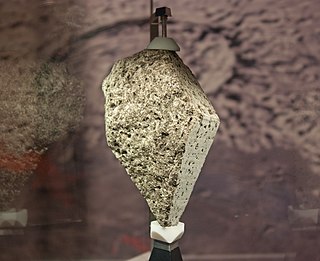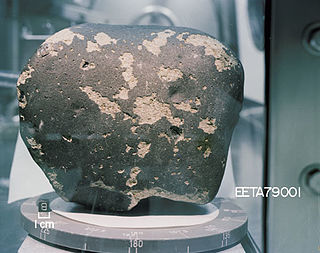
An impact crater is a circular depression in the surface of a solid astronomical object formed by the hypervelocity impact of a smaller object. In contrast to volcanic craters, which result from explosion or internal collapse, impact craters typically have raised rims and floors that are lower in elevation than the surrounding terrain. Lunar impact craters range from microscopic craters on lunar rocks returned by the Apollo program and small, simple, bowl-shaped depressions in the lunar regolith to large, complex, multi-ringed impact basins. Meteor Crater is a well-known example of a small impact crater on Earth.

Basalt is an aphanitic (fine-grained) extrusive igneous rock formed from the rapid cooling of low-viscosity lava rich in magnesium and iron exposed at or very near the surface of a rocky planet or moon. More than 90% of all volcanic rock on Earth is basalt. Rapid-cooling, fine-grained basalt is chemically equivalent to slow-cooling, coarse-grained gabbro. The eruption of basalt lava is observed by geologists at about 20 volcanoes per year. Basalt is also an important rock type on other planetary bodies in the Solar System. For example, the bulk of the plains of Venus, which cover ~80% of the surface, are basaltic; the lunar maria are plains of flood-basaltic lava flows; and basalt is a common rock on the surface of Mars.

In geology, the crust is the outermost solid shell of a rocky planet, dwarf planet, or natural satellite. It is usually distinguished from the underlying mantle by its chemical makeup; however, in the case of icy satellites, it may be distinguished based on its phase.

In planetary science, planetary differentiation is the process by which the chemical elements of a planetary body accumulate in different areas of that body, due to their physical or chemical behavior. The process of planetary differentiation is mediated by partial melting with heat from radioactive isotope decay and planetary accretion. Planetary differentiation has occurred on planets, dwarf planets, the asteroid 4 Vesta, and natural satellites.

Tektites are gravel-sized bodies composed of black, green, brown or grey natural glass formed from terrestrial debris ejected during meteorite impacts. The term was coined by Austrian geologist Franz Eduard Suess (1867–1941), son of Eduard Suess. They generally range in size from millimetres to centimetres. Millimetre-scale tektites are known as microtektites.

Andesite is a volcanic rock of intermediate composition. In a general sense, it is the intermediate type between silica-poor basalt and silica-rich rhyolite. It is fine-grained (aphanitic) to porphyritic in texture, and is composed predominantly of sodium-rich plagioclase plus pyroxene or hornblende.

Impactite is rock created or modified by one or more impacts of a meteorite. Impactites are considered metamorphic rock, because their source materials were modified by the heat and pressure of the impact. On Earth, impactites consist primarily of modified terrestrial material, sometimes with pieces of the original meteorite.

Moon rock or lunar rock is rock originating from Earth's Moon. This includes lunar material collected during the course of human exploration of the Moon, and rock that has been ejected naturally from the Moon's surface and landed on Earth as meteorites.

Pseudotachylyte is an extremely fine-grained to glassy, dark, cohesive rock occurring as veins that form through frictional melting and subsequent quenching during earthquakes, large-scale landslides, and impacts events. Chemical composition of pseudotachylyte generally reflects the local bulk chemistry, though may skew to slightly more mafic compositions due to the preferential incorporation of hydrous and ferro-magnesian minerals into the melt phase.
Susan Elizabeth Werner Kieffer is an American physical geologist and planetary scientist. Kieffer is known for her work on the fluid dynamics of volcanoes, geysers, and rivers, and for her model of the thermodynamic properties of complex minerals. She has also contributed to the scientific understanding of meteorite impacts.
Shock metamorphism or impact metamorphism describes the effects of shock-wave related deformation and heating during impact events.

The Tissint meteorite is a Martian meteorite that fell in Tata Province in the Guelmim-Es Semara region of Morocco on July 18, 2011. Tissint is the fifth Martian meteorite that people have witnessed falling to Earth, and the first since 1962. Pieces of the meteorite are on display at several museums, including the Museum of Natural History of Vienna and the Natural History Museum in London.
The Brachina meteorite is the type specimen of the brachinites class of the asteroidal achondrites.
This is a glossary of terms used in meteoritics, the science of meteorites.

Northwest Africa 7034 is a Martian meteorite believed to be the second oldest yet discovered. It is estimated to be two billion years old and contains the most water of any Martian meteorite found on Earth. Although it is from Mars it does not fit into any of the three SNC meteorite categories, and forms a new Martian meteorite group named "Martian ". Nicknamed "Black Beauty", it was purchased in Morocco and a slice of it was donated to the University of New Mexico by its American owner. The image of the original NWA 7034 was photographed in 2012 by Carl Agee, University of New Mexico.

Meteorite shock stage is a measure of the degree of fracturing of the matrix of a common chondrite meteorite. Impacts on the parent body of a meteoroid can produce very large pressures. These pressures heat, melt and deform the rocks. This is called shock metamorphism. Meteorites are often given a rating from 1 to 6 showing the level of shock metamorphism. However, the degree of shock can vary within a meteorite on the scale of centimeters.

Elephant Moraine 79001, also known as EETA 79001, is a Martian meteorite. It was found in Elephant Moraine, in the Antarctic during the 1979–1980 collecting season.
Reidite is a rare polymorph of ZrSiO4 created when zircon experiences high pressure and temperature. Reidite is denser than zircon and has the same crystal structure as scheelite. All natural occurrences of reidite are associated with meteorite impact events.
Padvarninkai meteorite is a meteorite that fell on 9 February 1929 near the village of Padvarninkai located near Andrioniškis, Anykščiai District Municipality, Lithuania. It is a rare eucrite that contains maskelynite and is highly shocked.
The upper mantle of Earth is a very thick layer of rock inside the planet, which begins just beneath the crust and ends at the top of the lower mantle at 670 km (420 mi). Temperatures range from approximately 500 K at the upper boundary with the crust to approximately 1,200 K at the boundary with the lower mantle. Upper mantle material that has come up onto the surface comprises about 55% olivine, 35% pyroxene, and 5 to 10% of calcium oxide and aluminum oxide minerals such as plagioclase, spinel, or garnet, depending upon depth.













